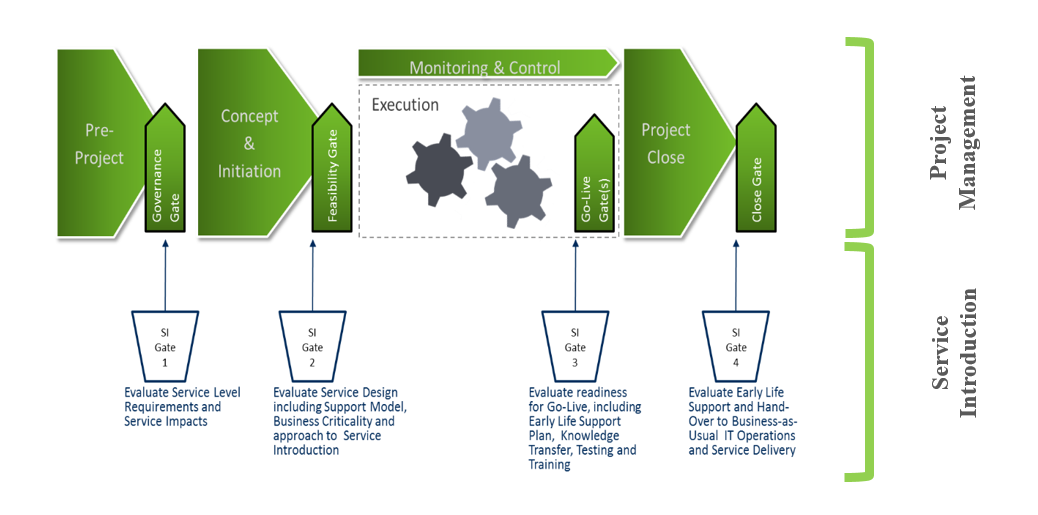Implementing Mars IS Service Introduction Process
“You will not have a second chance to make a first impression” - this aphorism perfectly describes the situation that arises when new IT services are introduced into service. In 2016, Mars IS switched to a new operating model consisting of 48 interconnected processes in order to ensure the effective operation of IT services. Along with such widely used processes as incident management, problems, changes, etc., the process of introducing new services into operation (Service Introduction) has entered the new operational model.

This process is actively and successfully used in world practice, just in the company "Mars" it was not formalized enough. Since the number of projects in the company is huge, as long as it is applicable to only the largest projects
According to an IT consultant from PA Consulting Tom McEvan, even well-planned projects for launching new services can quickly fail so much that the brand’s reputation will suffer, the expected income from their implementation will decrease and confidence in the IT department will disappear. provide quality services. Therefore, in his opinion, “IT-directors are constantly demanding the implementation of ready-to-launch solutions that do not have side effects, with the ability to receive real measurable benefits for the entire organization.” It is to prevent such failures in the new operating model of Mars IS entered the process of introducing new services into operation.
')
The service team should participate in the design of a new service at an early stage, in order to take into account irrelevant today, but in the near future there are even sharp questions, in particular, the purchase and maintenance of licenses, support, accessibility management, continuity, etc. The task of the Service Introduction process is and consists in posing these and other important questions and in finding answers to them.
The process involves taking into account the criteria to develop and put into operation a service that is optimal in quality and cost, meets the operational and other requirements of service teams. At the output of the project, we get a service accepted by the operations department for support, as well as service management documentation: a description of the service and an operation manual. The process applies to all projects that are designing a new service or subjecting a major change to an existing service.
The key role in the process belongs to the manager for the introduction of new services into service (Service Introduction manager). Usually this is an employee of the service team who will subsequently provide support for this service. It is the link between the project and service teams. Its task is to evaluate the designed service for a set of specific criteria, coordinate actions necessary to reduce the identified risks, as well as create documentation for managing the service. And its work begins with the creation of the Service Design Package document (service design documentation) in the planning and project organization phase.

As a process tool, a spreadsheet is used with a set of criteria according to which the manager for the introduction of new services into operation evaluates the designed service at different phases of the project. The criteria are grouped: operational requirements, finance, requirements for continuity and service levels, information security, etc. After identifying the risks in each group of criteria, the project team tries to minimize them, and the results of this work are documented.
We give a recent example from practice. Mars Service Desk suddenly began to receive calls about a service that was not in their competence. The support staff hardly found the necessary service team, transported incidents open to users in their turn. Another batch of calls from the same users followed: no one returned to them, and the incidents remained unresolved. The flaw in the project team is obvious: the support model was designed, the service was put into operation, but they forgot to inform all concerned parties. This situation very clearly demonstrates the importance of timely information. The process of introducing new services takes into account such a moment.
The benefits of the process are obvious, and it existed in one form or another and before its official introduction to Mars IS. It is about standardization and formalization, without which the task of planning and controlling the introduction of services into operation in a global organization is much more complicated.
In the next publication of our block, we will talk about how in our company there is a change in the vendor of services.

Universal tool to prevent crashes
This process is actively and successfully used in world practice, just in the company "Mars" it was not formalized enough. Since the number of projects in the company is huge, as long as it is applicable to only the largest projects
According to an IT consultant from PA Consulting Tom McEvan, even well-planned projects for launching new services can quickly fail so much that the brand’s reputation will suffer, the expected income from their implementation will decrease and confidence in the IT department will disappear. provide quality services. Therefore, in his opinion, “IT-directors are constantly demanding the implementation of ready-to-launch solutions that do not have side effects, with the ability to receive real measurable benefits for the entire organization.” It is to prevent such failures in the new operating model of Mars IS entered the process of introducing new services into operation.
')
Take care of everything in advance
The service team should participate in the design of a new service at an early stage, in order to take into account irrelevant today, but in the near future there are even sharp questions, in particular, the purchase and maintenance of licenses, support, accessibility management, continuity, etc. The task of the Service Introduction process is and consists in posing these and other important questions and in finding answers to them.
The process involves taking into account the criteria to develop and put into operation a service that is optimal in quality and cost, meets the operational and other requirements of service teams. At the output of the project, we get a service accepted by the operations department for support, as well as service management documentation: a description of the service and an operation manual. The process applies to all projects that are designing a new service or subjecting a major change to an existing service.
Who is responsible for everything?
The key role in the process belongs to the manager for the introduction of new services into service (Service Introduction manager). Usually this is an employee of the service team who will subsequently provide support for this service. It is the link between the project and service teams. Its task is to evaluate the designed service for a set of specific criteria, coordinate actions necessary to reduce the identified risks, as well as create documentation for managing the service. And its work begins with the creation of the Service Design Package document (service design documentation) in the planning and project organization phase.

As a process tool, a spreadsheet is used with a set of criteria according to which the manager for the introduction of new services into operation evaluates the designed service at different phases of the project. The criteria are grouped: operational requirements, finance, requirements for continuity and service levels, information security, etc. After identifying the risks in each group of criteria, the project team tries to minimize them, and the results of this work are documented.
Advantages of the new service
We give a recent example from practice. Mars Service Desk suddenly began to receive calls about a service that was not in their competence. The support staff hardly found the necessary service team, transported incidents open to users in their turn. Another batch of calls from the same users followed: no one returned to them, and the incidents remained unresolved. The flaw in the project team is obvious: the support model was designed, the service was put into operation, but they forgot to inform all concerned parties. This situation very clearly demonstrates the importance of timely information. The process of introducing new services takes into account such a moment.
The benefits of the process are obvious, and it existed in one form or another and before its official introduction to Mars IS. It is about standardization and formalization, without which the task of planning and controlling the introduction of services into operation in a global organization is much more complicated.
In the next publication of our block, we will talk about how in our company there is a change in the vendor of services.
Source: https://habr.com/ru/post/340528/
All Articles